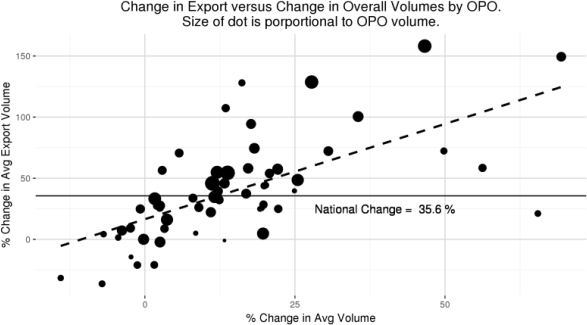Improved OPO Performance Drives Broader Organ Sharing in the United States
United Network for Organ Sharing, Richmond.
Meeting: 2018 American Transplant Congress
Abstract number: 369
Keywords: Allocation, Donation
Session Information
Session Name: Concurrent Session: Non-Organ Specific: Economics, Public Policy, Allocation, Ethics - 1
Session Type: Concurrent Session
Date: Monday, June 4, 2018
Session Time: 4:30pm-6:00pm
 Presentation Time: 5:30pm-5:42pm
Presentation Time: 5:30pm-5:42pm
Location: Room 4C-4
Background: OPTN allocation policies in the United States include both local geographic priority and broader sharing. Local allocation priority varies by organ type. For example, recently implemented policy allocates high KDPI kidneys and organs for high MELD liver candidates to the region rather than only to the DSA. Transplant numbers in the US have increased since 2014 largely driven by an increase in the number deceased donors. This study examines whether the increases in donor procurement by OPOs drives additional transplants primarily by local centers or through broader sharing.
Methods: OPTN data from 2009 through 2013 are compared to data from 2014 through 2016. Average annual volumes of all deceased donor transplants (DDTx) are compared to see whether the proportion and number of export (performed outside of DSA of donor recovery hospital) and local transplants has varied across DSAs and is related to OPO donor numbers.
Results: From 2009-2013 the US transplant volume ranged from 28,053 to 28,955 per year. Increases beginning in 2014 resulted in 33,610 transplants in 2016. Average OPO annual DDTx volumes increased by 13.9%. Local DDTx volume increased by 5.4% over this period while the percent of organs shared outside the DSA increased by 35.6%. Of the ten OPOs that increased their average annual DDTx volume the most (range: 24.9% – 69.4%), all but one increased their average export DDTx volume above the national rate of 35.6% (ranging from 21.1% to 158.1%). These OPOs with the largest percent increases ranged in size from of 122 to 995 DDTx per year. The figure shows that OPO growth is positively related to export volumes (dashed line: [rho]=0.64, p-value<0.01) and that many OPOs far exceeded the national rate (solid line at 35.6%) of exported transplants.
Conclusions: With improved logistics, preservation techniques, and allocation policies promoting broader sharing – OPOs have been able to implement strategies that increase their DDTx volumes by sharing organs outside of their DSA. While local demand still affects organ allocation and OPO practices, many OPOs are sharing organs beyond local waiting lists and driving a marked increase in broader sharing.
CITATION INFORMATION: Carrico R., Shepard B., Klassen D. Improved OPO Performance Drives Broader Organ Sharing in the United States Am J Transplant. 2017;17 (suppl 3).
To cite this abstract in AMA style:
Carrico R, Shepard B, Klassen D. Improved OPO Performance Drives Broader Organ Sharing in the United States [abstract]. https://atcmeetingabstracts.com/abstract/improved-opo-performance-drives-broader-organ-sharing-in-the-united-states/. Accessed December 20, 2025.« Back to 2018 American Transplant Congress

